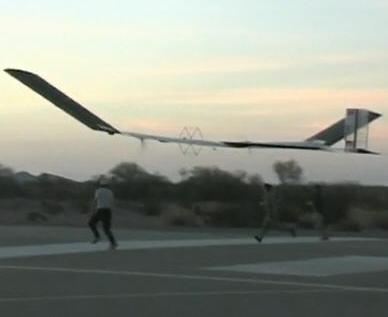|
|||||||||||
|
|
|
|||
|
By |
||||
 |
July 31, 2010 - Sion
Power announced that their proprietary lithium sulfur (Li-S) batteries
played a critical role in the QinetiQ Zephyr smashing the world record
for the longest duration unmanned flight. A result of an intensive joint development effort between Sion Power and QinetiQ, the Zephyr flight exceeded 336 hours (14 days) of continuous flight. Significantly surpassing the previous official record of 30 hours 24 minutes set by Northrop Grumman's RQ-4A Global Hawk in March 2001.
The Zephyr?s world
record flight was completed on July 23, 2010 at the US Army?s Yuma
Proving Grounds in ?This flight represents a major accomplishment for Sion?s lithium sulfur technology, proving the viability of our high energy, rechargeable battery system.? |
|||
|
|
||||
|
The Zephyr, a
solar/battery powered all electric UAV with a wing span of 70 feet (22.5
m) and a weight of just over 110 lbs. (50 kg), achieved this remarkable
record using a combination of solar power during the day and Sion
Power?s Li-S batteries at night. After a ground launch, the Zephyr flew
to altitudes of up to 70,000 feet, where the UAV encountered external
temperatures as low as minus 75?C.
The custom built
Li-S battery pack was designed and assembled by Sion Power in
?This flight
represents a major accomplishment for Sion?s lithium sulfur technology,
proving the viability of our high energy, rechargeable battery system,?
said Sion Power?s CEO, Dr. Dennis Mangino. |
||||
|
An official from
the Federation Aeronautique Internationale (FAI), the world air sports
federation, monitored the flight and is in the process of confirming a
number of new world records. This includes quadrupling the Zephyr?s
previous unofficial world record for longest duration unmanned flight,
82 hours, 37 minutes set in 2008.
Zephyr will also
have flown longer, non-stop and without refueling, than any other
airplane ? having significantly passed the Rutan Voyager milestone of 9
days (216 hours) 3 minutes and 44 seconds airborne, set in December
1986.
Once launched,
Zephyr can remain above a general area for weeks, if not months, at a
time delivering vital capability at a fraction of the cost of satellites
and significantly more cost effectively than other ?conventionally
powered? manned or unmanned aircraft.
Zephyr also does
not need to return to base at regular intervals for re-fuelling or
servicing which helps minimize the logistical supply chain, extending
its operational capability and appeal. Its zero emissions also make it
exceptionally environmentally friendly. |
|
|
| Other News Stories |
| ?AvStop
Online Magazine
Contact
Us
Return To News
|
|


